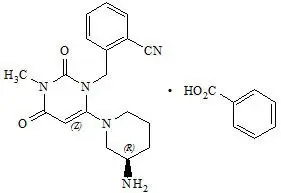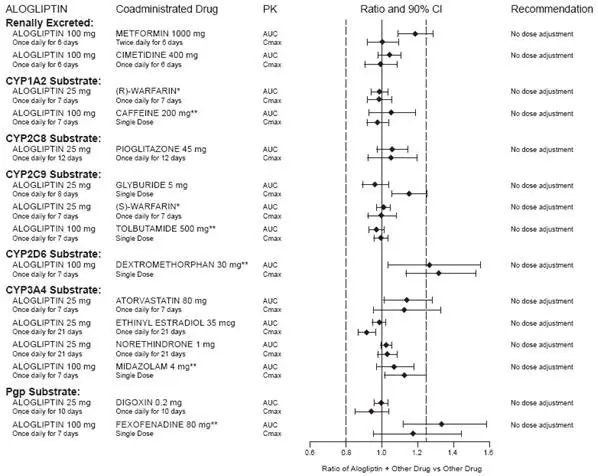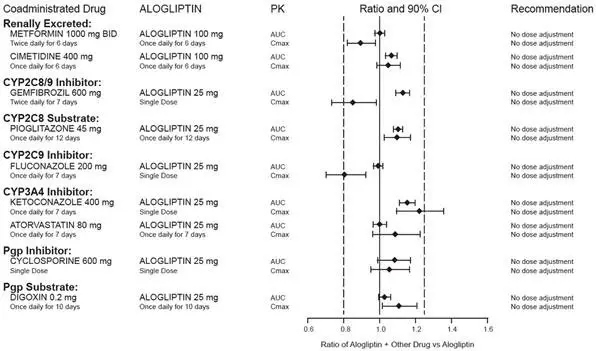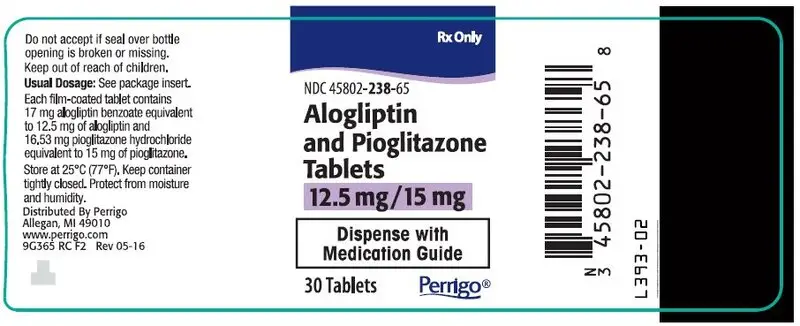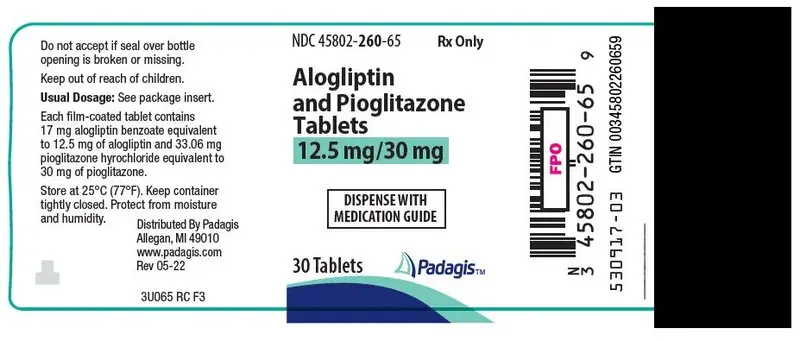Drug Detail:Alogliptin and metformin (Alogliptin and metformin [ al-oh-glip-tin-and-met-for-min ])
Drug Class: Antidiabetic combinations
Highlights of Prescribing Information
Alogliptin and Metformin Hydrochloride Tablets, for oral use
Initial U.S. Approval: 2013
WARNING: LACTIC ACIDOSIS
See full prescribing information for complete boxed warning.
- Postmarketing cases of metformin-associated lactic acidosis have resulted in death, hypothermia, hypotension, and resistant bradyarrhythmias. Symptoms included malaise, myalgias, respiratory distress, somnolence, and abdominal pain. Laboratory abnormalities included elevated blood lactate levels, anion gap acidosis, increased lactate/pyruvate ratio; and metformin plasma levels generally greater than 5 mcg/mL. (5.1)
- Risk factors include renal impairment, concomitant use of certain drugs, age ≥65 years old, radiological studies with contrast, surgery and other procedures, hypoxic states, excessive alcohol intake, and hepatic impairment. Steps to reduce the risk of and manage metformin-associated lactic acidosis in these high risk groups are provided in the Full Prescribing Information. (5.1)
- If lactic acidosis is suspected, discontinue alogliptin and metformin HCl tablets and institute general supportive measures in a hospital setting. Prompt hemodialysis is recommended. (5.1)
Indications and Usage for Alogliptin and Metformin Tablets
Alogliptin and metformin HCl tablets are a combination of alogliptin, a dipeptidyl-peptidase-4 (DPP-4) inhibitor and metformin, a biguanide indicated as an adjunct to diet and exercise to improve glycemic control in adults with type 2 diabetes mellitus. (1)
Limitations of Use: Should not be used in patients with type 1 diabetes mellitus. (1)
Alogliptin and Metformin Tablets Dosage and Administration
- Individualize the starting dose based on the patient's current regimen. (2.1)
- Give twice daily with food. (2.1)
- Adjust the dosing based on effectiveness and tolerability while not exceeding the maximum recommended daily dose of 25 mg alogliptin and 2000 mg metformin HCl. (2.1)
- Prior to initiation, assess renal function with estimated glomerular filtration rate (eGFR). (2.2)
- Do not use in patients with eGFR below 60 mL/min/1.73 m2.
- Alogliptin and metformin HCl tablets may need to be discontinued at time of, or prior to, iodinated contrast imaging procedures. (2.3)
Dosage Forms and Strengths
Tablets: 12.5 mg alogliptin and 500 mg metformin HCl, 12.5 mg alogliptin and 1000 mg metformin HCl. (3)
Contraindications
- Severe renal impairment: eGFR below 30 mL/min/1.73 m2. (4)
- Metabolic acidosis, including diabetic ketoacidosis. (4)
- History of a serious hypersensitivity reaction to alogliptin or metformin or any of the excipients. (4)
Warnings and Precautions
- Lactic acidosis: See boxed warning. (5.1)
- Pancreatitis: There have been postmarketing reports of acute pancreatitis. If pancreatitis is suspected, promptly discontinue alogliptin and metformin HCl tablets. (5.2)
- Heart failure: Consider the risks and benefits of alogliptin and metformin HCl tablets prior to initiating treatment in patients at risk for heart failure. If heart failure develops, evaluate and manage according to current standards of care and consider discontinuation of alogliptin and metformin HCl tablets. (5.3)
- Hypersensitivity: There have been postmarketing reports of serious hypersensitivity reactions in patients treated with alogliptin such as anaphylaxis, angioedema and severe cutaneous adverse reactions, including Stevens-Johnson syndrome. In such cases, promptly discontinue alogliptin and metformin HCl tablets, assess for other potential causes, institute appropriate monitoring and treatment and initiate alternative treatment for diabetes. (5.4)
- Hepatic effects: Postmarketing reports of hepatic failure, sometimes fatal. Causality cannot be excluded. If liver injury is detected, promptly interrupt alogliptin and metformin HCl tablets and assess patient for probable cause, then treat cause if possible, to resolution or stabilization. Do not restart alogliptin and metformin HCl tablets if liver injury is confirmed and no alternative etiology can be found. (5.5)
- Vitamin B12 deficiency: Metformin may lower vitamin B12 levels. Measure hematologic parameters annually and B12 at 2 to 3 year intervals and manage any abnormalties. (5.6)
- Hypoglycemia with Concomitant Use with Insulin or Insulin Secretaqoques: When used with an insulin secretagogue (e.g., sulfonylurea) or with insulin, a lower dose of the insulin secretagogue or insulin may be required to reduce the risk of hypoglycemia. (5.7)
- Arthralgia: Severe and disabling arthralgia has been reported in patients taking DPP-4 inhibitors. Consider as a possible cause for severe joint pain and discontinue drug if appropriate. (5.8)
- Bullous pemphigoid: There have been postmarketing reports of bullous pemphigoid requiring hospitalization in patients taking DPP-4 inhibitors. Tell patients to report development of blisters or erosions. If bullous pemphigoid is suspected, discontinue alogliptin and metformin HCl tablets. (5.9)
Adverse Reactions/Side Effects
The most common adverse reactions (4% or greater incidence) are upper respiratory tract infection, nasopharyngitis, diarrhea, hypertension, headache, back pain and urinary tract infection. (6.1)
To report SUSPECTED ADVERSE REACTIONS, contact Takeda Pharmaceuticals at 1-877-TAKEDA-7 or FDA at 1-800-FDA-1088 or www.fda.gov/medwatch.
Drug Interactions
- Carbionic anhydrase inhibitors may increase risk of lactic acidosis. Consider more frequent monitoring. (7)
- Drugs that reduce metformin clearance (such as ranolazine, vandetanib, dolutegravir, and cimetidine), may increase the accumulation of metformin. Consider the benefits and risks of concomitant use. (7)
- Alcohol can potentiate the effect of metformin on lactate metabolism. Warn patients against excessive alcohol intake. (7)
Use In Specific Populations
- Females and Males of Reproductive Potential: Advise premenopausal females of the potential for an unintended pregnancy.(8.3)
- Pediatrics: Safety and effectiveness of alogliptin and metformin HCl tablets in patients below the age of 18 have not been established. (8.4)
- Geriatric Use: Assess renal function more frequently. (8.5)
- Hepatic Impairment: Avoid use in patients with hepatic impairment. (8.7)
See 17 for PATIENT COUNSELING INFORMATION and Medication Guide.
Revised: 3/2022
Full Prescribing Information
WARNING: LACTIC ACIDOSIS
Postmarketing cases of metformin-associated lactic acidosis have resulted in death, hypothermia, hypotension, and resistant bradyarrhythmias. The onset of metformin-associated lactic acidosis is often subtle, accompanied only by nonspecific symptoms such as malaise, myalgias, respiratory distress, somnolence, and abdominal pain. Metformin-associated lactic acidosis was characterized by elevated blood lactate levels (greater than 5 mmol/L), anion gap acidosis (without evidence of ketonuria or ketonemia), an increased lactate/pyruvate ratio; and metformin plasma levels generally greater than 5 mcg/mL [see Warnings and Precautions (5.1)].
Risk factors for metformin-associated lactic acidosis include renal impairment, concomitant use of certain drugs (e.g., carbonic anhydrase inhibitors such as topiramate), age 65 years old or greater, having a radiological study with contrast, surgery and other procedures, hypoxic states (e.g., acute congestive heart failure), excessive alcohol intake, and hepatic impairment.
Steps to reduce the risk of and manage metformin-associated lactic acidosis in these high risk groups are provided in the Full Prescribing Information [see Dosage and Administration (2.2), Contraindications (4), Warnings and Precautions (5.1), Drug Interactions (7), and Use in Specific Populations (8.6, 8.7)].
If metformin-associated lactic acidosis is suspected, immediately discontinue alogliptin and metformin HCl tablets and institute general supportive measures in a hospital setting. Prompt hemodialysis is recommended [see Warnings and Precautions (5.1)].
1. Indications and Usage for Alogliptin and Metformin Tablets
Alogliptin and metformin HCl tablets are indicated as an adjunct to diet and exercise to improve glycemic control in adults with type 2 diabetes mellitus.
2. Alogliptin and Metformin Tablets Dosage and Administration
2.1 Recommendations for All Patients
- Healthcare providers should individualize the starting dose of alogliptin and metformin HCl tablets based on the patient's current regimen.
- Alogliptin and metformin HCl tablets should be taken twice daily with food with gradual dose escalation to reduce the gastrointestinal (GI) side effects due to metformin. Do not split tablets.
- Dosing may be adjusted based on effectiveness and tolerability while not exceeding the maximum recommended daily dose of 25 mg alogliptin and 2000 mg metformin hydrochloride (HCl).
- The following doses are available:
- 12.5 mg alogliptin and 500 mg metformin HCl
- 12.5 mg alogliptin and 1000 mg metformin HCl
2.2 Recommendations for Use in Renal Impairment
Assess renal function prior to initiation of alogliptin and metformin HCl tablets and periodically thereafter.
Alogliptin and metformin HCl tablets is contraindicated in patients with an estimated glomerular filtration rate (eGFR) below 30 mL/min/1.73 m2 [see Contraindications (4) and Warnings and Precautions (5.1)].
Alogliptin and metformin HCl tablets are not recommended in patients with an eGFR between 30 and 59 mL/min/1.73 m2 because these patients require a lower daily dosage of alogliptin than what is available in the fixed combination alogliptin and metformin HCl tablets product.
Alogliptin and metformin HCl tablets require no dose adjustment in patients with an eGFR of 60 mL/min/1.73 m2 or greater.
2.3 Discontinuation for Iodinated Contrast Imaging Procedures
Discontinue alogliptin and metformin HCl tablets at the time of, or prior to, an iodinated contrast imaging procedure in patients with an eGFR between 30 and 60 mL/min/1.73 m2; in patients with a history of liver disease, alcoholism or heart failure; or in patients who will be administered intra-arterial iodinated contrast. Re-evaluate eGFR 48 hours after the imaging procedure; restart alogliptin and metformin HCl tablets if renal function is stable [see Warnings and Precautions (5.1)].
3. Dosage Forms and Strengths
- 12.5 mg/500 mg tablets are pale yellow, oblong, film-coated tablets with "12.5/500" debossed on one side and "322M" debossed on the other side
- 12.5 mg/1000 mg tablets are pale yellow, oblong, film-coated tablets with "12.5/1000" debossed on one side and "322M" debossed on the other side
4. Contraindications
Alogliptin and metformin HCl tablets are contraindicated in patients with:
- Severe renal impairment (eGFR below 30 mL/min/1.73 m2) [see Warnings and Precautions (5.1)].
- Acute or chronic metabolic acidosis, including diabetic ketoacidosis with or without coma.
- Serious hypersensitivity reaction to alogliptin or metformin or any of the exciptients, such as anaphylaxis, angioedema and severe cutaneous adverse reactions [see Warnings and Precautions (5.4), Adverse Reactions (6.2)].
5. Warnings and Precautions
5.2 Pancreatitis
Acute pancreatitis has been reported in the postmarketing setting and in randomized clinical trials. In glycemic control trials in patients with type 2 diabetes, acute pancreatitis was reported in 6 (0.2%) patients treated with alogliptin 25 mg and 2 (<0.1%) patients treated with active comparators or placebo. In the EXAMINE trial (a cardiovascular outcomes trial of patients with type 2 diabetes and high cardiovascular (CV) risk), acute pancreatitis was reported in 10 (0.4%) patients treated with alogliptin and in 7 (0.3%) patients treated with placebo.
It is unknown whether patients with a history of pancreatitis are at increased risk for pancreatitis while using alogliptin and metformin HCl tablets.
After initiation of alogliptin and metformin HCl tablets, patients should be observed for signs and symptoms of pancreatitis. If pancreatitis is suspected, alogliptin should promptly be discontinued and appropriate management should be initiated.
5.3 Heart Failure
In the EXAMINE trial which enrolled patients with type 2 diabetes and recent acute coronary syndrome, 106 (3.9%) of patients treated with alogliptin and 89 (3.3%) of patients treated with placebo were hospitalized for congestive heart failure.
Consider the risks and benefits of alogliptin and metformin HCl tablets prior to initiating treatment in patients at risk for heart failure, such as those with a prior history of heart failure and a history of renal impairment, and observe these patients for signs and symptoms of heart failure during therapy. Patients should be advised of the characteristic symptoms of heart failure and should be instructed to immediately report such symptoms. If heart failure develops, evaluate and manage according to current standards of care and consider discontinuation of alogliptin and metformin HCl tablets.
5.4 Hypersensitivity Reactions
There have been postmarketing reports of serious hypersensitivity reactions in patients treated with alogliptin. These reactions include anaphylaxis, angioedema and severe cutaneous adverse reactions, including Stevens-Johnson syndrome. If a serious hypersensitivity reaction is suspected, discontinue alogliptin and metformin HCl tablets, assess for other potential causes for the event and institute alternative treatment for diabetes [see Adverse Reactions (6.2)]. Use caution in patients with a history of angioedema with another dipeptidyl peptidase-4 (DPP-4) inhibitor because it is unknown whether such patients will be predisposed to angioedema with alogliptin and metformin HCl tablets.
5.5 Hepatic Effects
There have been postmarketing reports of fatal and nonfatal hepatic failure in patients taking alogliptin, although some of the reports contain insufficient information necessary to establish the probable cause [see Adverse Reactions (6.2)].
In glycemic control trials in patients with type 2 diabetes, serum alanine aminotransferase (ALT) elevations greater than three times the upper limit of normal (ULN) were reported in 1.3% of patients treated with alogliptin 25 mg and 1.7% of patients treated with active comparators or placebo. In the EXAMINE trial (a cardiovascular outcomes trial of patients with type 2 diabetes and high cardiovascular (CV) risk), increases in serum alanine aminotransferase three times the upper limit of the reference range occurred in 2.4% of patients treated with alogliptin and in 1.8% of patients treated with placebo.
Measure liver tests promptly in patients who report symptoms that may indicate liver injury, including fatigue, anorexia, right upper abdominal discomfort, dark urine or jaundice. In this clinical context, if the patient is found to have clinically significant liver enzyme elevations and if abnormal liver tests persist or worsen, alogliptin and metformin HCl tablets should be interrupted and investigation done to establish the probable cause. Alogliptin and metformin HCl tablets should not be restarted in these patients without another explanation for the liver test abnormalities.
5.6 Vitamin B12 Levels
In metformin clinical trials of 29-week duration, a decrease to subnormal levels of previously normal serum vitamin B12 levels was observed in approximately 7% of patients. Such decrease, possibly due to interference with B12 absorption from the B12-intrinsic factor complex, may be associated with anemia but appears to be rapidly reversible with discontinuation of metformin or vitamin B12 supplementation. Certain individuals (those with inadequate vitamin B12 or calcium intake or absorption) appear to be predisposed to developing subnormal vitamin B12 levels. Measure hematologic parameters on an annual basis and vitamin B12 at 2 to 3 year intervals in patients on alogliptin with metformin and manage any abnormalities [see Adverse Reactions (6.1)].
5.7 Hypoglycemia with Concomitant Use with Insulin or Insulin Secretagogues
Insulin and insulin secretagogues, such as sulfonylureas, are known to cause hypoglycemia. Therefore, a lower dose of insulin or insulin secretagogue may be required to minimize the risk of hypoglycemia when used in combination with alogliptin and metformin HCl tablets.
5.8 Severe and Disabling Arthralgia
There have been postmarketing reports of severe and disabling arthralgia in patients taking DPP-4 inhibitors. The time to onset of symptoms following initiation of drug therapy varied from one day to years. Patients experienced relief of symptoms upon discontinuation of the medication. A subset of patients experienced a recurrence of symptoms when restarting the same drug or a different DPP-4 inhibitor. Consider DPP- 4 inhibitors as a possible cause for severe joint pain and discontinue drug if appropriate.
5.9 Bullous Pemphigoid
Postmarketing cases of bullous pemphigoid requiring hospitalization have been reported with DPP-4 inhibitor use. In reported cases, patients typically recovered with topical or systemic immunosuppressive treatment and discontinuation of DPP-4 inhibitor. Tell patients to report development of blisters or erosions while receiving alogliptin and metformin HCl tablets. If bullous pemphigoid is suspected, alogliptin and metformin HCl tablets should be discontinued and referral to a dermatologist should be considered for diagnosis and appropriate treatment.
6. Adverse Reactions/Side Effects
The following serious adverse reactions are described below or elsewhere in the prescribing information:
- Pancreatitis [see Warnings and Precautions (5.2)]
- Heart Failure [see Warnings and Precautions (5.3)]
- Hypersensitivity Reactions [see Warnings and Precautions (5.4)]
- Hepatic Effects [see Warnings and Precautions (5.5)]
- Severe and Disabling Arthralgia [see Warnings and Precautions (5.8)]
- Bullous Pemphigoid [see Warnings and Precautions (5.9)]
6.1 Clinical Trials Experience
Because clinical trials are conducted under widely varying conditions, adverse reaction rates observed in the clinical trials of a drug cannot be directly compared to rates in the clinical trials of another drug and may not reflect the rates observed in practice.
Alogliptin and Metformin Hydrochloride
Over 2700 patients with type 2 diabetes have received alogliptin coadministered with metformin in four large, randomized, double-blind controlled clinical trials. The mean exposure to alogliptin and metformin HCl tablets was 58 weeks, with more than 1400 subjects treated for more than one year. These included two 26 week placebo-controlled studies, one 52 week active control study and an interim analysis of a 104 week active-controlled study. In the alogliptin and metformin HCl tablets arm, the mean duration of diabetes was approximately six years, the mean body mass index (BMI) was 31 kg/m2 (56% of patients had a BMI ≥30 kg/m2) and the mean age was 55 years (18% of patients ≥65 years of age).
In a pooled analysis of these four controlled clinical studies, the overall incidence of adverse reactions was 74% in patients treated with alogliptin and metformin HCl tablets compared to 75% treated with placebo. Overall discontinuation of therapy due to adverse reactions was 6.2% with alogliptin and metformin HCl tablets compared to 1.9% in placebo, 6.4% in metformin and 5.0% in alogliptin.
Adverse reactions reported in ≥4% of patients treated with alogliptin and metformin HCl tablets and more frequently than in patients who received alogliptin, metformin or placebo are summarized in Table 1.
| Number of Patients (%) | ||||
|---|---|---|---|---|
| Alogliptin and Metformin HCl Tablets* | Alogliptin† | Metformin‡ | Placebo | |
|
||||
| N=2794 | N=222 | N=1592 | N=106 | |
| Upper respiratory tract infection | 224 (8.0) | 6 (2.7) | 105 (6.6) | 3 (2.8) |
| Nasopharyngitis | 191 (6.8) | 7 (3.2) | 93 (5.8) | 2 (1.9) |
| Diarrhea | 155 (5.5) | 4 (1.8) | 105 (6.6) | 3 (2.8) |
| Hypertension | 154 (5.5) | 5 (2.3) | 96 (6.0) | 6 (5.7) |
| Headache | 149 (5.3) | 11 (5.0) | 74 (4.6) | 3 (2.8) |
| Back pain | 119 (4.3) | 1 (0.5) | 72 (4.5) | 1 (0.9) |
| Urinary tract infection | 116 (4.2) | 4 (1.8) | 59 (3.7) | 2 (1.9) |
Alogliptin
A total of 14,778 patients with type 2 diabetes participated in 14 randomized, double-blind, controlled clinical trials of whom 9052 subjects were treated with alogliptin, 3469 subjects were treated with placebo and 2257 were treated with an active comparator. The mean duration of diabetes was seven years, the mean body mass index (BMI) was 31 kg/m2 (49% of patients had a BMI ≥30 kg/m2), and the mean age was 58 years (26% of patients ≥65 years of age). The mean exposure to alogliptin was 49 weeks with 3348 subjects treated for more than one year.
In a pooled analysis of these 14 controlled clinical trials, the overall incidence of adverse reactions was 73% in patients treated with alogliptin 25 mg compared to 75% with placebo and 70% with active comparator. Overall discontinuation of therapy due to adverse reactions was 6.8% with alogliptin 25 mg compared to 8.4% with placebo or 6.2% with active comparator.
Adverse reactions reported in ≥4% of patients treated with alogliptin 25 mg and more frequently than in patients who received placebo are summarized in Table 2.
| Number of Patients (%) | |||
|---|---|---|---|
| Alogliptin 25 mg | Placebo | Active Comparator | |
| N=6447 | N=3469 | N=2257 | |
| Nasopharyngitis | 309 (4.8) | 152 (4.4) | 113 (5.0) |
| Upper Respiratory Tract Infection | 287 (4.5) | 121 (3.5) | 113 (5.0) |
| Headache | 278 (4.3) | 101 (2.9) | 121 (5.4) |
Metformin Hydrochloride
| Adverse Reaction | Metformin Monotherapy (n=141) | Placebo (n=145) |
|---|---|---|
| % of Patients | ||
|
||
| Diarrhea | 53.2 | 11.7 |
| Nausea/vomiting | 25.5 | 8.3 |
| Flatulence | 12.1 | 5.5 |
| Asthenia | 9.2 | 5.5 |
| Indigestion | 7.1 | 4.1 |
| Abdominal discomfort | 6.4 | 4.8 |
| Headache | 5.7 | 4.8 |
6.2 Postmarketing Experience
The following adverse reactions have been identified during postmarketing use. Because these reactions are reported voluntarily from a population of uncertain size, it is not always possible to reliably estimate their frequency or establish a causal relationship to drug exposure.
8. Use In Specific Populations
8.2 Lactation
Data
Published clinical lactation studies report that metformin is present in human milk which resulted in infant doses approximately 0.11% to 1% of the maternal weight-adjusted dosage and a milk/plasma ratio (based on AUC) ranging between 0.13 and 1. However, the studies were not designed to definitely establish the risk of use of metformin during lactation because of small sample size and limited adverse event data collected in infants.
8.3 Females and Males of Reproductive Potential
There is the potential for unintended pregnancy with premenopausal women as therapy with metformin may result in ovulation in some premenopausal anovulatory women.
8.4 Pediatric Use
Safety and effectiveness of alogliptin and metformin HCl tablets in pediatric patients have not been established.
8.6 Renal Impairment
Metformin is substantially excreted by the kidney, and the risk of metformin accumulation and lactic acidosis increases with the degree of renal impairment. Alogliptin and metformin HCl tablets is contraindicated in severe renal impairment, patients with an eGFR below 30 mL/min/1.73 m2 [see Dosage and Administration (2.2), Contraindications (4), Warnings and Precautions (5.1) and Clinical Pharmacology (12.3)].
11. Alogliptin and Metformin Tablets Description
Alogliptin and metformin HCl tablets contain two oral antihyperglycemic drugs used in the management of type 2 diabetes: alogliptin and metformin hydrochloride.
12. Alogliptin and Metformin Tablets - Clinical Pharmacology
12.3 Pharmacokinetics
Special Populations
Drug Interactions
Metformin Hydrochloride
Pharmacokinetic drug interaction studies have been performed on metformin (Tables 4 and 5).
| Coadministered Drug | Dose of Coadministered Drug* | Dose of Metformin HCl* | Geometric Mean Ratio (ratio with/without coadministered drug) No effect = 1.00 | |
|---|---|---|---|---|
| AUC† | Cmax | |||
|
||||
| No dosing adjustments required for the following: | ||||
| Glyburide | 5 mg | 500 mg‡ | 0.98§ | 0.99§ |
| Furosemide | 40 mg | 850 mg | 1.09§ | 1.22§ |
| Nifedipine | 10 mg | 850 mg | 1.16 | 1.21 |
| Propranolol | 40 mg | 850 mg | 0.90 | 0.94 |
| Ibuprofen | 400 mg | 850 mg | 1.05§ | 1.07§ |
| Drugs that are eliminated by renal tubular secretion may increase the accumulation of metformin [see Warnings and Precautions (5) and Drug Interactions (7)]. | ||||
| Cimetidine | 400 mg | 850 mg | 1.40 | 1.61 |
| Carbonic anhydrase inhibitors may cause metabolic acidosis [see Warnings and Precautions (5) and Drug Interactions (7)] | ||||
| Topiramate | 100 mg¶ | 500 mg¶ | 1.25¶ | 1.17 |
| Coadministered Drug | Dose of Coadministered Drug* | Dose of Metformin HCl* | Geometric Mean Ratio (ratio with/without coadministered drug) No effect = 1.00 | |
|---|---|---|---|---|
| AUC† | Cmax | |||
|
||||
| No dosing adjustments required for the following: | ||||
| Glyburide | 5 mg | 500 mg‡ | 0.78§ | 0.63§ |
| Furosemide | 40 mg | 850 mg | 0.87§ | 0.69§ |
| Nifedipine | 10 mg | 850 mg | 1.10‡ | 1.08 |
| Propranolol | 40 mg | 850 mg | 1.01‡ | 0.94 |
| Ibuprofen | 400 mg | 850 mg | 0.97¶ | 1.01¶ |
| Cimetidine | 400 mg | 850 mg | 0.95‡ | 1.01 |
14. Clinical Studies
The coadministration of alogliptin and metformin has been studied in patients with type 2 diabetes inadequately controlled on either diet and exercise alone, on metformin alone or metformin in combination with a thiazolidinedione.
There have been no clinical efficacy studies conducted with alogliptin and metformin HCl tablets; however, bioequivalence of alogliptin and metformin HCl tablets with coadministered alogliptin and metformin tablets was demonstrated, and efficacy of the combination of alogliptin and metformin has been demonstrated in three Phase 3 efficacy studies.
A total of 2095 patients with type 2 diabetes were randomized in three double-blind, placebo- or active-controlled clinical safety and efficacy studies conducted to evaluate the effects of alogliptin and metformin HCl tablets on glycemic control. The racial distribution of patients exposed to study medication was 69.2% white, 16.3% Asian, 6.5% black and 8.0% other racial groups. The ethnic distribution was 24.3% Hispanic. Patients had an overall mean age of approximately 54.4 years (range 22 to 80 years). In patients with type 2 diabetes, treatment with alogliptin and metformin HCl tablets produced clinically meaningful and statistically significant improvements in A1C versus comparator. As is typical for trials of agents to treat type 2 diabetes, the mean reduction in hemoglobin A1c (A1C) with alogliptin and metformin HCl tablets appears to be related to the degree of A1C elevation at baseline.
Alogliptin and Metformin Coadministration in Patients with Type 2 Diabetes Inadequately Controlled on Diet and Exercise
In a 26 week, double-blind, placebo-controlled study, a total of 784 patients inadequately controlled on diet and exercise alone (mean baseline A1C = 8.4%) were randomized to one of seven treatment groups: placebo; metformin HCl 500 mg or metformin HCl 1000 mg twice daily, alogliptin 12.5 mg twice daily, or alogliptin 25 mg daily; alogliptin 12.5 mg in combination with metformin HCl 500 mg or metformin HCl 1000 mg twice daily. Both coadministration treatment arms (alogliptin 12.5 mg + metformin HCl 500 mg and alogliptin 12.5 mg + metformin HCl 1000 mg) resulted in significant improvements in A1C (Figure 3) and FPG when compared with their respective individual alogliptin and metformin component regimens (Table 6). Coadministration treatment arms demonstrated improvements in two-hour postprandial glucose (PPG) compared to alogliptin alone or metformin alone (Table 6). A total of 12% of patients receiving alogliptin 12.5 mg + metformin HCl 500 mg, 3% of patients receiving alogliptin 12.5 mg + metformin HCl 1000 mg, 17% of patients receiving alogliptin 12.5 mg, 23% of patients receiving metformin HCl 500 mg, 11% of patients receiving metformin HCl 1000 mg and 39% of patients receiving placebo required glycemic rescue.
Improvements in A1C were not affected by gender, age, race or baseline BMI. The mean decrease in body weight was similar between metformin alone and alogliptin when coadministered with metformin. Lipid effects were neutral.
| Placebo | Alogliptin 12.5 mg twice daily | Metformin HCl 500 mg twice daily | Metformin HCl 1000 mg twice daily | Alogliptin 12.5 mg + Metformin HCl 500 mg twice daily | Alogliptin 12.5 mg + Metformin HCl 1000 mg twice daily | |
|---|---|---|---|---|---|---|
|
||||||
| A1C (%)* | N=102 | N=104 | N=103 | N=108 | N=102 | N=111 |
| Baseline (mean) | 8.5 | 8.4 | 8.5 | 8.4 | 8.5 | 8.4 |
| Change from baseline (adjusted mean†) | 0.1 | -0.6 | -0.7 | -1.1 | -1.2 | -1.6 |
| Difference from metformin (adjusted mean† with 95% confidence interval) | - | - | - | - | -0.6‡
(-0.9, -0.3) | -0.4‡
(-0.7, -0.2) |
| Difference from alogliptin (adjusted mean† with 95% confidence interval) | - | - | - | - | -0.7‡
(-1.0, -0.4) | -1.0‡
(-1.3, -0.7) |
| % of Patients (n/N) achieving A1C <7%§ | 4% (4/102) | 20% (21/104) | 27% (28/103) | 34% (37/108) | 47%‡
(48/102) | 59%‡
(66/111) |
| FPG (mg/dL)* | N=105 | N=106 | N=106 | N=110 | N=106 | N=112 |
| Baseline (mean) | 187 | 177 | 180 | 181 | 176 | 185 |
| Change from baseline (adjusted mean†) | 12 | -10 | -12 | -32 | -32 | -46 |
| Difference from metformin (adjusted mean† with 95% confidence interval) | - | - | - | - | -20‡
(-33, -8) | -14‡
(-26, -2) |
| Difference from alogliptin (adjusted mean† with 95% confidence interval) | - | - | - | - | -22‡
(-35, -10) | -36‡
(-49, -24) |
| 2-Hour PPG (mg/dL)¶ | N=26 | N=34 | N=28 | N=37 | N=31 | N=37 |
| Baseline (mean) | 263 | 272 | 247 | 266 | 261 | 268 |
| Change from baseline (adjusted mean†) | -21 | -43 | -49 | -54 | -68 | -86‡ |
| Difference from metformin (adjusted mean† with 95% confidence interval) | - | - | - | - | -19 (-49, 11) | -32‡
(-58, -5) |
| Difference from alogliptin (adjusted mean† with 95% confidence interval) | - | - | - | - | -25 (-53, 3) | -43‡
(-70, -16) |
Figure 3. Change from Baseline A1C at Week 26 with Alogliptin and Metformin Alone and Alogliptin in Combination with Metformin
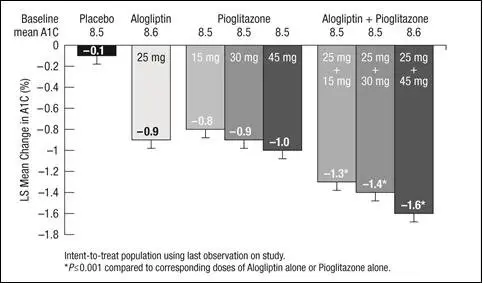
Alogliptin and Metformin Coadministration in Patients with Type 2 Diabetes Inadequately Controlled on Metformin Alone
In a 26 week, double-blind, placebo-controlled study, a total of 527 patients already on metformin (mean baseline A1C = 8%) were randomized to receive alogliptin 12.5 mg, alogliptin 25 mg, or placebo once daily. Patients were maintained on a stable dose of metformin HCl (median daily dose = 1700 mg) during the treatment period. Alogliptin 25 mg in combination with metformin resulted in statistically significant improvements from baseline in A1C and FPG at Week 26, when compared to placebo (Table 7). A total of 8% of patients receiving alogliptin 25 mg and 24% of patients receiving placebo required glycemic rescue. Improvements in A1C were not affected by gender, age, race, baseline BMI or baseline metformin dose.
The mean decrease in body weight was similar between alogliptin 25 mg and placebo when given in combination with metformin. Lipid effects were also neutral.
| Alogliptin 25 mg + Metformin | Placebo + Metformin | |
|---|---|---|
|
||
| A1C (%) | N=203 | N=103 |
| Baseline (mean) | 7.9 | 8.0 |
| Change from baseline (adjusted mean†) | -0.6 | -0.1 |
| Difference from placebo (adjusted mean† with 95% confidence interval) | -0.5‡ (-0.7, -0.3) | ˗ |
| % of patients (n/N) achieving A1C ≤7%‡ | 44% (92/207)‡ | 18% (19/104) |
| FPG (mg/dL) | N=204 | N=104 |
| Baseline (mean) | 172 | 180 |
| Change from baseline (adjusted mean†) | -17 | 0 |
| Difference from placebo (adjusted mean† with 95% confidence interval) | -17‡ (-26, -9) | ˗ |
Alogliptin Add-On Therapy in Patients with Type 2 Diabetes Inadequately Controlled on the Combination of Metformin and Pioglitazone
In a 52 week, active-comparator study, a total of 803 patients inadequately controlled (mean baseline A1C = 8.2%) on a current regimen of pioglitazone 30 mg and metformin were randomized to either receive the addition of once-daily alogliptin 25 mg or the titration of pioglitazone 30 mg to 45 mg following a four-week single-blind, placebo run-in period. Patients were maintained on a stable dose of metformin HCl (median daily dose = 1700 mg). Patients who failed to meet prespecified hyperglycemic goals during the 52 week treatment period received glycemic rescue therapy.
In combination with pioglitazone and metformin, alogliptin 25 mg was shown to be statistically superior in lowering A1C and FPG compared with the titration of pioglitazone from 30 to 45 mg at Week 26 and at Week 52 (Table 8). A total of 11% of patients in the alogliptin 25 mg in combination with pioglitazone 30 mg and metformin treatment group and 22% of patients in the up titration of pioglitazone in combination with metformin treatment group required glycemic rescue. Improvements in A1C were not affected by gender, age, race or baseline BMI.
The mean increase in body weight was similar in both treatment arms. Lipid effects were neutral.
| Alogliptin 25 mg + Pioglitazone 30 mg + Metformin | Pioglitazone 45 mg + Metformin | |
|---|---|---|
|
||
| A1C (%) | N=397 | N=394 |
| Baseline (mean) | 8.2 | 8.1 |
| Change from baseline (adjusted mean†) | -0.7 | -0.3 |
| Difference from pioglitazone 45 mg + metformin*(adjusted mean† with 95% confidence interval) | -0.4‡ (-0.5, -0.3) | ˗ |
| % of Patients (n/N) achieving A1C ≤7% | 33% (134/404)§ | 21% (85/399) |
| Fasting Plasma Glucose (mg/dL)‡ | N=399 | N=396 |
| Baseline (mean) | 162 | 162 |
| Change from baseline (adjusted mean†) | -15 | -4 |
| Difference from pioglitazone 45 mg + metformin (adjusted mean† with 95% confidence interval) | -11§ (-16, -6) | ˗ |
Cardiovascular Safety Trial
A randomized, double-blind, placebo-controlled cardiovascular outcomes trial (EXAMINE) was conducted to evaluate the cardiovascular risk of alogliptin. The trial compared the risk of major adverse cardiovascular events (MACE) between alogliptin (N=2701) and placebo (N=2679) when added to standard of care therapies for diabetes and atherosclerotic vascular disease (ASCVD). The trial was event driven and patients were followed until a sufficient number of primary outcome events accrued.
Eligible patients were adults with type 2 diabetes who had inadequate glycemic control at baseline (e.g., HbA1c >6.5%) and had been hospitalized for an acute coronary syndrome event (e.g., acute myocardial infarction or unstable angina requiring hospitalization) 15 to 90 days prior to randomization. The dose of alogliptin was based on estimated renal function at baseline per dosage and administration recommendations. The average time between an acute coronary syndrome event and randomization was approximately 48 days.
The mean age of the population was 61 years. Most patients were male (68%), Caucasian (73%), and were recruited from outside of the United States (86%). Asian and Black patients contributed 20% and 4% of the total population, respectively. At the time of randomization patients had a diagnosis of type 2 diabetes mellitus for approximately 9 years, 87% had a prior myocardial infarction and 14% were current smokers. Hypertension (83%) and renal impairment (27% with an eGFR ≤60 ml/min/1.73 m2) were prevalent co-morbid conditions. Use of medications to treat diabetes (e.g., metformin 73%, sulfonylurea 54%, insulin 41%), and ASCVD (e.g., statin 94%, aspirin 93%, renin-angiotensin system blocker 88%, beta-blocker 87%) was similar between patients randomized to alogliptin and placebo at baseline. During the trial, medications to treat diabetes and ASCVD could be adjusted to ensure care for these conditions adhered to standard of care recommendations set by local practice guidelines.
The primary endpoint in EXAMINE was the time to first occurrence of a MACE defined as the composite of cardiovascular death, nonfatal myocardial infarction (MI), or nonfatal stroke. The study was designed to exclude a pre-specified risk margin of 1.3 for the hazard ratio of MACE. The median exposure to study drug was 526 days and 95% of the patients were followed to study completion or death.
Table 9 shows the study results for the primary MACE composite endpoint and the contribution of each component to the primary MACE endpoint. The upper bound of the confidence interval was 1.16 and excluded a risk margin larger than 1.3.
|
|||||
| Composite of first event of CV death, nonfatal MI or nonfatal stroke (MACE) | Alogliptin | Placebo | Hazard Ratio | ||
| Number of Patients (%) | Rate per 100 PY* | Number of Patients (%) | Rate per 100 PY* | (98% CI) | |
| N=2701 | N=2679 | ||||
| 305 (11.3) | 7.6 | 316 (11.8) | 7.9 | 0.96 (0.80, 1.16) | |
| CV Death | 89 (3.3) | 2.2 | 111 (4.1) | 2.8 | |
| Non-fatal MI | 187 (6.9) | 4.6 | 173 (6.5) | 4.3 | |
| Non-fatal stroke | 29 (1.1) | 0.7 | 32 (1.2) | 0.8 | |
The Kaplan-Meier based cumulative event probability is presented in Figure 4 for the time to first occurrence of the primary MACE composite endpoint by treatment arm. The curves for placebo and alogliptin overlap throughout the duration of the study. The observed incidence of MACE was highest within the first 60 days after randomization in both treatment arms (14.8 MACE per 100 PY), decreased from day 60 to the end of the first year (8.4 per 100 PY) and was lowest after 1 year of follow-up (5.2 per 100 PY).
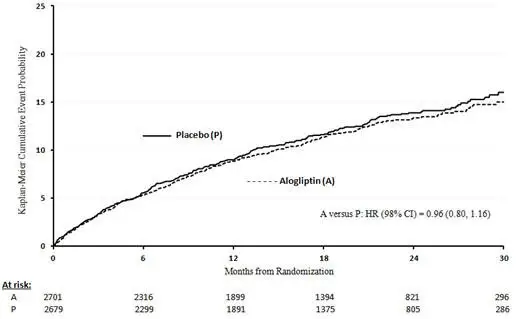 |
The rate of all cause death was similar between treatment arms with 153 (3.6 per 100 PY) recorded among patients randomized to alogliptin and 173 (4.1 per 100 PY) among patients randomized to placebo. A total of 112 deaths (2.9 per 100 PY) among patients on alogliptin and 130 among patients on placebo (3.5 per 100 PY) were adjudicated as cardiovascular deaths.
16. How is Alogliptin and Metformin Tablets supplied
Alogliptin and metformin HCl tablets are available in the following strengths and packages: 12.5 mg/500 mg tablet: pale yellow, oblong, film-coated tablets with "12.5/500" debossed on one side and "322M" debossed on the other side, available in:
| NDC 45802-169-72 | Bottles of 60 tablets |
12.5 mg/1000 mg tablet: pale yellow, oblong, film-coated tablets with "12.5/1000" debossed on one side and "322M" debossed on the other side, available in:
| NDC 45802-211-72 | Bottles of 60 tablets |
17. Patient Counseling Information
Advise the patient to read the FDA-approved patient labeling (Medication Guide)
| ALOGLIPTIN AND METFORMIN HYDROCHLORIDE
alogliptin and metformin hydrochloride tablet, film coated |
||||||||||||||||||||||
|
||||||||||||||||||||||
|
||||||||||||||||||||||
|
||||||||||||||||||||||
|
||||||||||||||||||||||
|
||||||||||||||||||||||
|
||||||||||||||||||||||
| ALOGLIPTIN AND METFORMIN HYDROCHLORIDE
alogliptin and metformin hydrochloride tablet, film coated |
||||||||||||||||||||||
|
||||||||||||||||||||||
|
||||||||||||||||||||||
|
||||||||||||||||||||||
|
||||||||||||||||||||||
|
||||||||||||||||||||||
|
||||||||||||||||||||||
| Labeler - Padagis Israel Pharmaceuticals Ltd (600093611) |




